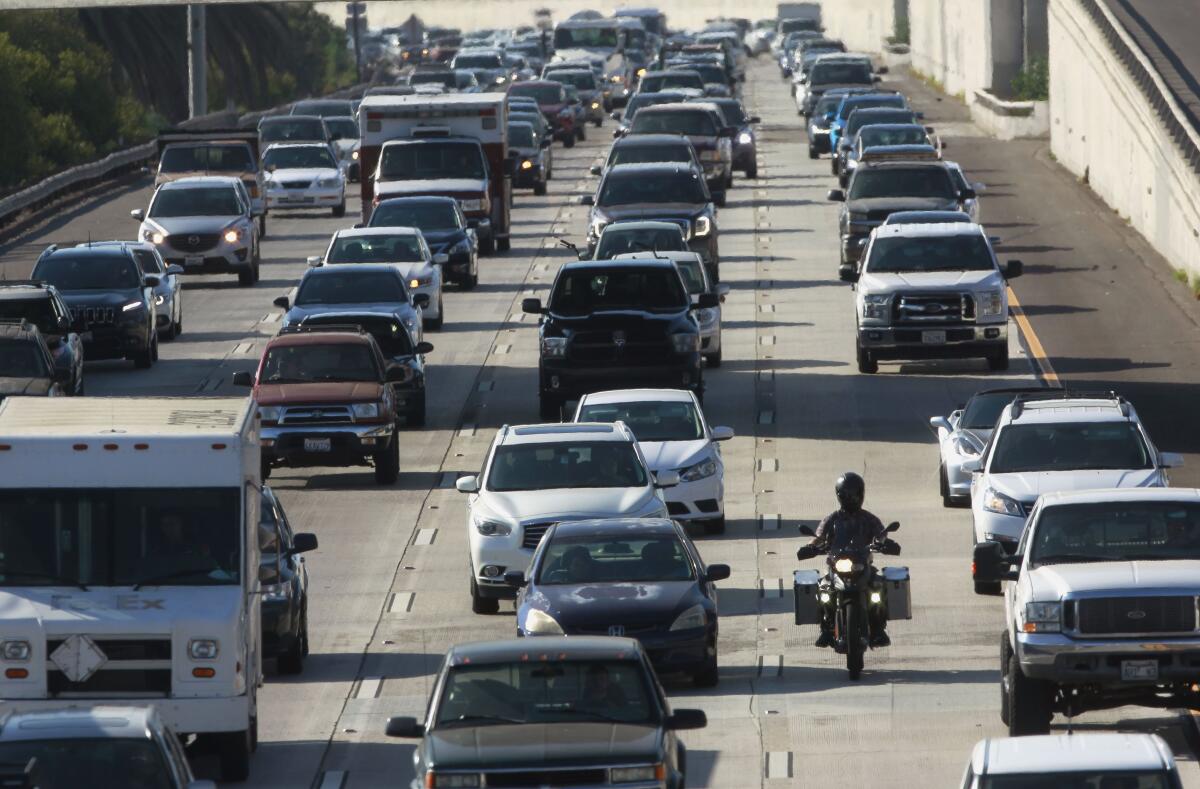Opinion: Trump’s bad faith auto emissions mandate is another example of presidential power run amok

President Trump says he’s canceling California’s ability to enact tough vehicle emissions standards for several reasons, but none of them fit what Congress had in mind when it granted the state the ability to keep adopting clean-air rules in 1967.
This is just the latest example of the Trump administration abusing the discretion Congress afforded the executive branch — a flexibility intended to make laws more workable and adaptable to changing circumstances, not to let presidents try to subvert Congress’ intent. The list includes numerous uses of “national security” exemptions to impose tariffs on trading partners and even close allies, to threaten to penalize Mexico for allowing Central American migrants to cross into the United States and to shift funds from military construction projects into a wall along the southern border.
Before you shout “DACA!” at your screen, allow me to note that Trump’s predecessors also stretched the boundaries of federal statutes in pursuit of their agendas. But President Obama’s Deferred Action for Childhood Arrivals is a good example of the sort of liberties he and other presidents have taken. DACA relied on the discretion granted by Congress to set enforcement priorities to carve out a class of people who would be exempt from deportation.
Trump’s attack on California’s ability to set emissions standards is something else entirely. Congress often preempts state and local laws on issues of national importance to avert a confusing patchwork of state requirements. When Congress enacted tailpipe emission limits in 1967, though, it recognized that California had already adopted regulations to try to clean its especially smoggy air. So the law preempted state rules on vehicle emissions, it also required the federal government to allow California to continue regulating, provided that its rules were tougher than the federal standards.
“The Secretary shall, after notice and opportunity for public hearing, waive application of this section to any State which has adopted standards (other than crankcase emission standards) for the control of emissions from new motor vehicles or new motor vehicle engines prior to March 30, 1966, unless he finds that such State does not require standards more stringent than applicable Federal standards to meet compelling and extraordinary conditions or that such State standards and accompanying enforcement procedures are not consistent with section 202(a) of this title,” the law states. Section 202(a) is the one calling on the federal government to set standards for emissions from new vehicles that cause or contribute to air pollution that “endangers the health or welfare of any persons.”
Subsequent versions of the Clean Air Act retain this exemption with similar limits, guaranteeing California the right to adopt tougher tailpipe standards to address its air quality problems as long as they’re in line with the overall purpose of the law.
So, what is Trump’s justification for yanking the waiver? Here’s what he tweeted Wednesday morning:
The “safer” argument, which has been debunked, has nothing to do with air quality. And making cars cheaper, which Trump lauds as a way to increase sales and “JOBS! JOBS! JOBS!” is only tangentially related to cutting smog; his argument is that more people will trade in older, dirtier cars for new, greener ones if the prices are lower.
But nothing in the law requires California’s standards to be more effective at cutting emissions than the federal government’s. Instead, the law leaves it to California to determine if its standards “will be, in the aggregate, at least as protective of public health and welfare” as the feds’ rules.
State officials suggested that the administration may try to use the Energy Policy and Conservation Act, which preempts state laws setting fuel economy standards, to block California’s vehicle emissions standards. But those are two different animals — fuel economy standards were introduced to reduce U.S. dependence on imported oil, while the tailpipe emission limits are designed to combat smog and other forms of air pollution. California is using the latter to address greenhouse gas emissions too, which the Supreme Court has recognized as a pollutant qualified for regulation.
According to a report by Harvard Law School’s Energy and Environmental Law Program: “Two federal district courts have held, for separate reasons, that the Energy Policy and Conservation Act does not preempt California’s pollution standards, and that fuel economy standards can coexist with pollution standards. In addition, the Supreme Court has held that pollution standards and fuel economy standards are legally distinct and aimed at fulfilling different congressional purposes, noting … there is no reason to think the two agencies cannot both administer their obligations and yet avoid inconsistency.”
It’s just appalling to see the administration try to stop a state with lingering smog problems and ambitious greenhouse-gas targets from reducing tailpipe emissions. Naturally, California officials pledged to fight; said Atty. Gen. Xavier Becerra, “When you endanger our people, our economy, or our planet, we rise with the full force of the law behind us.”
Again, this fits into this administration’s practice of contorting the law to achieve its ends. And it offers an important lesson for Congress: Before lawmakers grant the executive branch discretion in carrying out a law, they need to consider how that discretion might be used by a president acting in bad faith.
More to Read
A cure for the common opinion
Get thought-provoking perspectives with our weekly newsletter.
You may occasionally receive promotional content from the Los Angeles Times.






